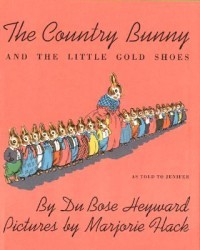A Special Easter Story from North Carolina
 The Country Bunny and the Little Gold Shoes is a sweet children’s story about a brown, female country bunny with 21 children who competes and wins against slicker-looking, mostly white, male bunnies for the coveted role of Easter Bunny. She then deploys scientific management principals to delegate household responsibilities to her extra-large brood so that she can go out and conduct her important holiday job. The story is delightful and surprising for two reasons: 1. the country bunny is an Afro-feminist heroine; 2. a White male southerner wrote the book in the late 1930s. What influenced author DuBose Heyward to create such an unusual and enchanting Easter story?
The Country Bunny and the Little Gold Shoes is a sweet children’s story about a brown, female country bunny with 21 children who competes and wins against slicker-looking, mostly white, male bunnies for the coveted role of Easter Bunny. She then deploys scientific management principals to delegate household responsibilities to her extra-large brood so that she can go out and conduct her important holiday job. The story is delightful and surprising for two reasons: 1. the country bunny is an Afro-feminist heroine; 2. a White male southerner wrote the book in the late 1930s. What influenced author DuBose Heyward to create such an unusual and enchanting Easter story?
One answer is that Heyward defined his literary career by creating Black (and often female) characters with strength and integrity. He was from an aristocratic Charleston family and scholars have speculated that Gullah (learned from his family’s servants) may have been his first language. As was common for Charleston elites, Heyward began spending summers in the North Carolina mountains near Hendersonville at property that he and his widowed mother purchased in 1917. After his marriage in 1923, Heyward built a substantial house, “Dawn Hill,” to serve as his family’s principal residence. The house still stands on Old Kanuga Road south of Hendersonville. He achieved literary fame after the publication of his novel Porgy (1925) and co-wrote the screenplay and music for the Broadway hit, “Porgy and Bess.” In 1939, while still living in Hendersonville, he published the children’s story he had made up for his daughter, Jenifer.
Another answer is that developments in the 1930s may have encouraged southern writers to expose fissures in the culture of segregation. Professor Benjamin Filene, Director of UNCG’s Public History Program, is currently researching this topic in his study of Stella Sharpe’s (a teacher from Hillsborough) 1939 book, Tobe. (See a selection of pages here.) Heyward’s treatment of Black characters was likely the most popularly successful and internationally renowned of his day. As contemporary black poet Langston Hughes commented, Heyward saw “with his white eyes, wonderful, poetic qualities in the inhabitants of Catfish Row that makes them come alive.”
A story hour at your institution this week with The Country Bunny and the Little Gold Shoes will celebrate both Easter and a significant North Carolina author.
Posted on March 26, 2013, in historic houses, public programs and tagged Benjamin Filene, Dawn Hill, DuBose Heyward, Hendersonville, The Country Bunny and the Little Gold Shoes, Tobe project, UNC Greensboro Museum Studies. Bookmark the permalink. 2 Comments.

Thanks for sharing this with me. I’m checking it out today to read it with a new perspective.
Pingback: A Special Easter Story | -- Let's Talk --